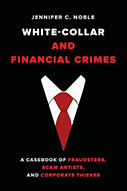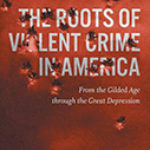White-Collar and Financial Crimes: A Casebook of Fraudsters, Scam Artists, and Corporate Thieves

Author: Jennifer C. Noble
Publisher: University of California Press, 2021. 192 pages
Reviewer: Colleen P. Eren ǀ November 2021
As academic departments are being consolidated across the U.S., it seems ever more likely that the disciplines of criminology, criminal justice, legal studies, and sociology will find themselves in a single department, and thus made to think in a more interdisciplinary and synergistic way about their programs. Additionally, students often look to minor or double major in another one of these disciplines. For example, a criminal justice student may look to minor or double major in legal studies. Given this reality, texts that can bridge these related subjects have practical (allowing for cross-listing, for instance) and pedagogical import. Noble’s White-Collar and Financial Crimes: A Casebook of Fraudsters, Scam Artists, and Corporate Thieves thus is a very useful interdisciplinary supplemental text. It can be used as a complement in a traditional white collar crime course found in a criminology, criminal justice or sociology program, bringing to that course a legal component, or vice versa.
This book is not intended to replace a more standard white collar crime textbook. It does not go over definitions, theories of offending, and typologies. Rather, it provides a case-based overview of major types of white-collar/financial crime: money laundering, cybercrime, Ponzi schemes, mortgage fraud, insider trading, academic fraud, false advertising, environmental crimes, health care fraud. In each chapter, Noble explains the case (all were very interesting and should spark student interest), why it is exemplary of the type of crime, the investigation process and agencies involved, the “how” and “why” of court proceedings, and the resolution/outcome. She avoids relying on the more hackneyed “famous” examples in favor of less well-known cases that are particularly well-suited for demonstrating legal processes and outcomes. Each chapter also includes extensive use of boxes providing verbatim, the relevant federal and state statutes. Other boxes provide text from the United States Sentencing Guidelines (USSG) for the relevant offenses, excerpts from the Department of Justice’s Justice Manual, and statements by the former Deputy Attorney General Rod Rosenstein on the Foreign Corrupt Practices Act.
Two chapters focus not on a type of crime, but rather on the peculiarities of white-collar/financial crime in terms of legal processes. Chapter 6 investigates Corporate Criminal Liability through the case of United States v General Motors, exploring the use of Deferred Prosecution Agreements or Non-Prosecution Agreements, even in the face of over 100 deaths linked to withholding safety concerns about a vehicle part from the National Highway Traffic Safety Administration. Chapter 9 is centered on the Foreign Corrupt Practices Act and violations of that Act (enacted in 1977), using the case of United States v Avon Products (China), Inc., wherein a Chinese subsidiary of the U.S.-based company self-reported to the Securities and Exchange commission about its gross violations of that Act.
I would have liked to have seen in the book more of a seamless integration of the amply used “legal” boxes with the text itself, and/or that those boxes were more thoughtfully placed/less interruptive. Many times, the boxes with the verbatim of statutes interrupts the chapter’s progress without an explanation of why the box was in that location. One resolution would have been to put the statutes in an appendix at the back of each chapter or at the back of the book and then to reference them in the text. The boxes also could have culled the more relevant information (in some cases, pages of statutes were used). Points of interest could have been highlighted or called out, and certain legal concepts explained. Relatedly, since this is a supplemental text, a glossary or list of key terms with definitions in an appendix would be student-friendly, and perhaps a short introductory chapter explaining some of the agencies entrusted with investigating white-collar/financial crimes, the USSG, and other basics that then can be elaborated on in the chapters to follow.
Overall, Noble’s case-based text should provide students with an accessible, interesting, and well-structured entrée into thinking about white-collar and financial crimes, and the complex legal processes that surround them. Her writing avoids specialized jargon, remains admirably objective, and is suitable for undergraduates in a range of social science disciplines, but especially criminal justice, criminology, sociology, legal studies or forensic studies. Her text fills a gap in bridging related disciplines that should more often speak to each other through thoughtful pedagogy.
Colleen P. Eren is an Associate Professor of Sociology and Criminal Justice at William Paterson University


